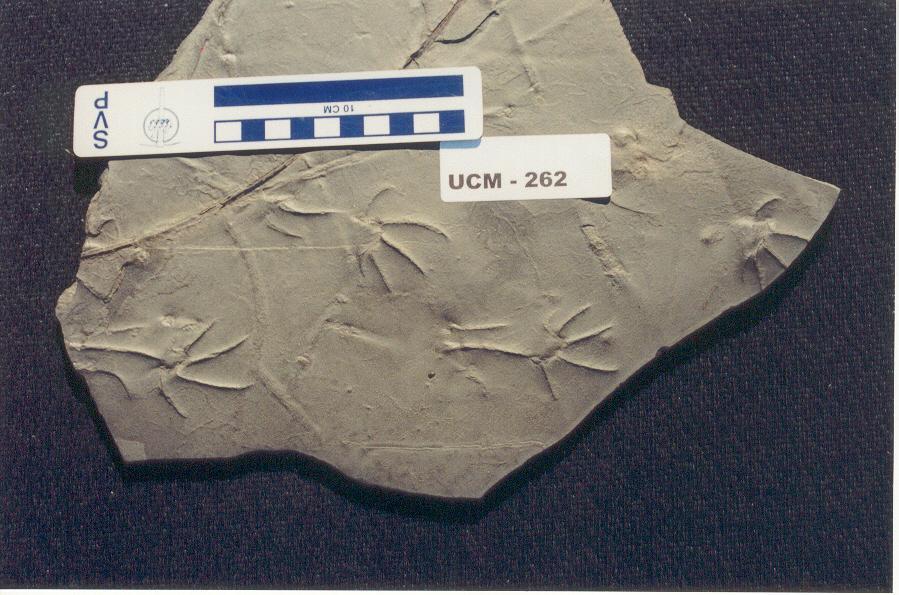Press Release
WORLD-CLASS FOSSIL DISCOVERY IN NORTHWEST ALABAMA
Just prior to the July 4th holiday last week, U.S. Representative Robert Aderholt (District 4) visited an extraordinary fossil discovery just northwest of Birmingham in Walker County. Hosting Rep. Aderholt and his aide Bill Harris in a tour of the site were members of the Birmingham Paleontological Society (BPS), a local amateur fossil group, and a number of professional geologists and paleontologists who have participated in studying the fossils that have been recovered so far from the site.
“This is the most important discovery of Carboniferous Period tracks known; there is no comparable site in the world,” stated Prescott Atkinson, a physician at Children’s Hospital and a member of the BPS. He was quoting from a letter sent to Rep. Aderholt from Professor Hartmut Haubold, a German paleontologist who is widely considered one of the world’s leading experts on fossil animal tracks. Professor Haubold had written to Representative Aderholt in support of protecting the fossil site for scientific research after seeing the photographic database of more than 1300 track specimens compiled by Dr. Ron Buta, a University of Alabama astronomy professor and BPS member. Prof. Haubold’s assessment of the site: “by quantity, by quality, and by geological age, it is the most important discovery of Carboniferous tracks hitherto known.” This assessment was further strengthened in another letter sent to Representative Aderholt by renowned fossil track specialist Jerry MacDonald (author of Earth’s First Steps: Tracking Life Before the Dinosaurs), who visited the Walker County site in April 2002. In the late 1980’s Mr. MacDonald found an extensive pre-dinosaur tracksite in New Mexico that dates from the Permian Period, some 30 million years “younger” than the Walker County site.

Picture 1: Paleontologist Dr. Andy Rindsberg explains fossil tracks to Representative Aderholt

Picture 2: Rep. Aderholt and his aide Bill Harris (center) examine fossil tracks with Drs. Atkinson (L) and Rindsberg (R)
During the tour of the area, Dr. Jack Pashin, a coal geologist with the Geological Survey of Alabama, discussed the ancient history of the rocks at the site. The sediment (mud, dirt, and sand) that became shale rock and the plant material that became coal were laid down there about 310 million years ago in a swampy river delta during the Carboniferous Period (“Coal Age”), many millions of years before the dinosaurs. Dr. Jim Lacefield, adjunct professor at the University of North Alabama and author of Lost Worlds in Alabama Rocks, continued with the ancient history of the area, explaining that this part of Alabama was near the equator when these sediments were deposited. He explained that an ocean covered much of North America to the west and south of the present day location of Walker County. Dr. Andy Rindsberg, a paleontologist with the Geological Survey of Alabama, took Aderholt and Harris around several tables to examine specimens of vertebrate and invertebrate tracks that have been recovered from the site, some that very morning. Vertebrate tracks ranged from smaller than a fingernail to larger than a hand. Bruce Relihan, Curator of Horticulture with the Birmingham Zoo and a member of BPS, showed the Congressman some examples of the many plant fossils that the site has yielded and presented him with a small amphibian trackway, found that morning at the site. Steve Minkin, a geologist with Westinghouse in Anniston, finished the tour by explaining that there are several acres of undisturbed strata at the site, and that preservation of the site could be accomplished by including an engineered design to leave the undisturbed track-bearing rock prepared for a proper paleontological excavation.

Picture 3: Large fossil amphibian trackway

Picture 4: Fossil amphibian trackway

Picture 5: Fossil fish scale
The site is located at a small surface coal mine owned by the New Acton Coal Company, and the group expressed their appreciation for the generosity of the company in allowing this world-class collection of fossil tracks to be assembled from broken rock in the spoil areas. If the undisturbed rock beds still remaining in the site are properly excavated in the future, the testimony of the experts indicates that the scientific and educational value of the site will be of truly international significance. In fact, several school field trips have already taken place at the site under the supervision of Ashley Allen, an Oneonta High School science teacher. Mr. Allen, also a BPS member, originally discovered the tracks after being led to the site by one of his students, the grandson of Mrs. Delores Reid, owner of New Acton Coal Company. Together the BPS fossil enthusiasts and their professional collaborators are proposing that the site could be developed as an important regional attraction for Alabama, with easy access from U.S. Highway 78 and, soon, Corridor X. A small building onsite could serve as a museum and visitor’s center that would house many of the tracks already collected, plus tracks excavated during a future paleontological dig. Similar to other sites out West, a pre-fabricated, portable building could be placed over an ongoing excavation and serve to protect the research and allow school classes and the public to observe paleontologists at work.
Much work remains before the vision of saving the site can be realized. Representative Aderholt is considering introducing legislation that would preserve the site for future scientific development. Alabama has already entered scientific history as home to a world-class Coal Age track site, and even more discoveries may lie ahead.
For further information, please contact
Dr. Andy Rindsberg (205-349-2852, e-mail: arindsberg@gsa.state.al.us)
Dr. Prescott Atkinson (205-934-7054, e-mail: patkinso@uab.edu)
Dr. Ron Buta (205-348-3792, e-mail: rbuta@bama.ua.edu)
